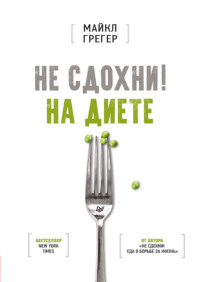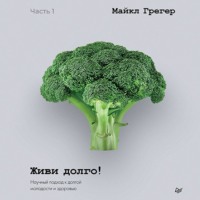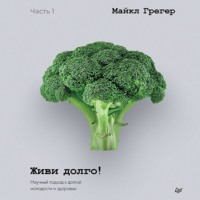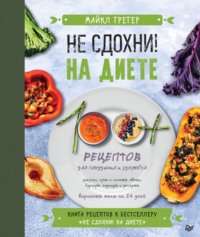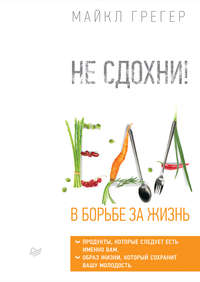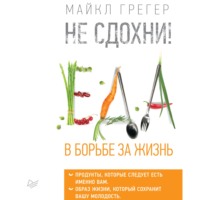
Полная версия
Живи долго! Научный подход к долгой молодости и здоровью
384
Cipolla BG, Havouis R, Moulinoux JP. Polyamine contents in current foods: a basis for polyamine reduced diet and a study of its long term observance and tolerance in prostate carcinoma patients. Amino Acids. 2007;33(2):203–12. https://pubmed.ncbi.nlm.nih.gov/17578651/
385
Atiya Ali M, Poortvliet E, Strömberg R, Yngve A. Polyamines in foods: development of a food database. Food Nutr Res. 2011;55(1):5572. https://pubmed.ncbi.nlm.nih.gov/21249159/
386
Atiya Ali M, Poortvliet E, Strömberg R, Yngve A. Polyamines in foods: development of a food database. Food Nutr Res. 2011;55(1):5572. https://pubmed.ncbi.nlm.nih.gov/21249159/
387
Kiechl S, Pechlaner R, Willeit P, et al. Higher spermidine intake is linked to lower mortality: a prospective population-based study. Am J Clin Nutr. 2018;108(2):371–80. https://pubmed.ncbi.nlm.nih.gov/29955838/
388
Atiya Ali M, Poortvliet E, Strömberg R, Yngve A. Polyamines in foods: development of a food database. Food Nutr Res. 2011;55(1):5572. https://pubmed.ncbi.nlm.nih.gov/21249159/
389
Nishimura K, Shiina R, Kashiwagi K, Igarashi K. Decrease in polyamines with aging and their ingestion from food and drink. J Biochem. 2006;139(1):81–90. https://pubmed.ncbi.nlm.nih.gov/16428322/
390
Cipolla BG, Havouis R, Moulinoux JP. Polyamine contents in current foods: a basis for polyamine reduced diet and a study of its long term observance and tolerance in prostate carcinoma patients. Amino Acids. 2007;33(2):203–12. https://pubmed.ncbi.nlm.nih.gov/17578651/
391
Kiechl S, Pechlaner R, Willeit P, et al. Higher spermidine intake is linked to lower mortality: a prospective population-based study. Am J Clin Nutr. 2018;108(2):371–80. https://pubmed.ncbi.nlm.nih.gov/29955838/
392
Atiya Ali M, Poortvliet E, Strömberg R, Yngve A. Polyamines in foods: development of a food database. Food Nutr Res. 2011;55(1):5572. https://pubmed.ncbi.nlm.nih.gov/21249159/
393
Atiya Ali M, Poortvliet E, Strömberg R, Yngve A. Polyamines in foods: development of a food database. Food Nutr Res. 2011;55(1):5572. https://pubmed.ncbi.nlm.nih.gov/21249159/
394
Kalac P. Health effects and occurrence of dietary polyamines: a review for the period 2005–mid 2013. Food Chem. 2014;161:27–39. https://pubmed.ncbi.nlm.nih.gov/24837918/
395
Kiechl S, Pechlaner R, Willeit P, et al. Higher spermidine intake is linked to lower mortality: a prospective population-based study. Am J Clin Nutr. 2018;108(2):371–80. https://pubmed.ncbi.nlm.nih.gov/29955838/
396
Kiechl S, Pechlaner R, Willeit P, et al. Higher spermidine intake is linked to lower mortality: a prospective population-based study. Am J Clin Nutr. 2018;108(2):371–80. https://pubmed.ncbi.nlm.nih.gov/29955838/
397
Cipolla BG, Havouis R, Moulinoux JP. Polyamine contents in current foods: a basis for polyamine reduced diet and a study of its long term observance and tolerance in prostate carcinoma patients. Amino Acids. 2007;33(2):203–12. https://pubmed.ncbi.nlm.nih.gov/17578651/
398
Cipolla BG, Havouis R, Moulinoux JP. Polyamine contents in current foods: a basis for polyamine reduced diet and a study of its long term observance and tolerance in prostate carcinoma patients. Amino Acids. 2007;33(2):203–12. https://pubmed.ncbi.nlm.nih.gov/17578651/
399
Nishibori N, Fujihara S, Akatuki T. Amounts of polyamines in foods in Japan and intake by Japanese. Food Chem. 2007;100(2):491–7. https://www.sciencedirect.com/science/article/abs/pii/S0308814605008915?via%3Dihub
400
Nishimura K, Shiina R, Kashiwagi K, Igarashi K. Decrease in polyamines with aging and their ingestion from food and drink. J Biochem. 2006;139(1):81–90. https://pubmed.ncbi.nlm.nih.gov/16428322/
401
Atiya Ali M, Poortvliet E, Strömberg R, Yngve A. Polyamines in foods: development of a food database. Food Nutr Res. 2011;55(1):5572. https://pubmed.ncbi.nlm.nih.gov/21249159/
402
Nishimura K, Shiina R, Kashiwagi K, Igarashi K. Decrease in polyamines with aging and their ingestion from food and drink. J Biochem. 2006;139(1):81–90. https://pubmed.ncbi.nlm.nih.gov/16428322/
403
Kiechl S, Pechlaner R, Willeit P, et al. Higher spermidine intake is linked to lower mortality: a prospective population-based study. Am J Clin Nutr. 2018;108(2):371–80. https://pubmed.ncbi.nlm.nih.gov/29955838/
404
Atiya Ali M, Poortvliet E, Strömberg R, Yngve A. Polyamines in foods: development of a food database. Food Nutr Res. 2011;55(1):5572. https://pubmed.ncbi.nlm.nih.gov/21249159/
405
Atiya Ali M, Poortvliet E, Strömberg R, Yngve A. Polyamines in foods: development of a food database. Food Nutr Res. 2011;55(1):5572. https://pubmed.ncbi.nlm.nih.gov/21249159/
406
Zoumas-Morse C, Rock CL, Quintana EL, Neuhouser ML, Gerner EW, Meyskens FL. Development of a polyamine database for assessing dietary intake. J Am Diet Assoc. 2007;107(6):1024–7. https://pubmed.ncbi.nlm.nih.gov/17524725/
407
Buyukuslu N, Hizli H, Esin K, Garipagaoglu M. A cross-sectional study: nutritional polyamines in frequently consumed foods of the Turkish population. Foods. 2014;3(4):541–57. https://pubmed.ncbi.nlm.nih.gov/28234336/
408
Nishibori N, Fujihara S, Akatuki T. Amounts of polyamines in foods in Japan and intake by Japanese. Food Chem. 2007;100(2):491–7. https://www.sciencedirect.com/science/article/abs/pii/S0308814605008915?via%3Dihub
409
Reis GCL, Dala-Paula BM, Tavano OL, Guidi LR, Godoy HT, Gloria MBA. In vitro digestion of spermidine and amino acids in fresh and processed Agaricus bisporus mushroom. Food Res Int. 2020;137:109616. https://pubmed.ncbi.nlm.nih.gov/33233206/
410
Pietrocola F, Castoldi F, Kepp O, Carmona-Gutierrez D, Madeo F, Kroemer G. Spermidine reduces cancer-related mortality in humans. Autophagy. 2019;15(2):362–5. https://pubmed.ncbi.nlm.nih.gov/30354939/
411
Nishimura K, Shiina R, Kashiwagi K, Igarashi K. Decrease in polyamines with aging and their ingestion from food and drink. J Biochem. 2006;139(1):81–90. https://pubmed.ncbi.nlm.nih.gov/16428322/
412
Eisenberg T, Abdellatif M, Schroeder S, et al. Cardioprotection and lifespan extension by the natural polyamine spermidine. Nat Med. 2016;22(12):1428–38. https://pubmed.ncbi.nlm.nih.gov/27841876/
413
Atiya Ali M, Poortvliet E, Strömberg R, Yngve A. Polyamines in foods: development of a food database. Food Nutr Res. 2011;55(1):5572. https://pubmed.ncbi.nlm.nih.gov/21249159/
414
Agricultural Research Service, United States Department of Agriculture. Mangos, raw. FoodData Central. https://fdc.nal.usda.gov/fdc-app.html#/food-details/169910/nutrients. Published April 2018. Accessed February 10, 2023.; https://fdc.nal.usda.gov/fdc-app.html#/food-details/169910/nutrients
415
Nishimura K, Shiina R, Kashiwagi K, Igarashi K. Decrease in polyamines with aging and their ingestion from food and drink. J Biochem. 2006;139(1):81–90. https://pubmed.ncbi.nlm.nih.gov/16428322/
416
Atiya Ali M, Poortvliet E, Strömberg R, Yngve A. Polyamines in foods: development of a food database. Food Nutr Res. 2011;55(1):5572. https://pubmed.ncbi.nlm.nih.gov/21249159/
417
Soda K, Binh P, Kawakami M. Mediterranean diet and polyamine intake: possible contribution of increased polyamine intake to inhibition of age-associated disease. NDS. Published online December 2010:1.; https://www.dovepress.com/mediterranean-diet-and-polyamine-intake-possible-contribution-of-incre-peer-reviewed-fulltext-article-NDS
418
Atiya Ali M, Poortvliet E, Strömberg R, Yngve A. Polyamines in foods: development of a food database. Food Nutr Res. 2011;55(1):5572. https://pubmed.ncbi.nlm.nih.gov/21249159/
419
Okamoto A, Sugi E, Koizumi Y, Yanagida F, Udaka S. Polyamine content of ordinary foodstuffs and various fermented foods. Biosci Biotechnol Biochem. 1997;61(9):1582–4. https://pubmed.ncbi.nlm.nih.gov/9339564/
420
Atiya Ali M, Poortvliet E, Strömberg R, Yngve A. Polyamines in foods: development of a food database. Food Nutr Res. 2011;55(1):5572. https://pubmed.ncbi.nlm.nih.gov/21249159/
421
Atiya Ali M, Poortvliet E, Strömberg R, Yngve A. Polyamines in foods: development of a food database. Food Nutr Res. 2011;55(1):5572. https://pubmed.ncbi.nlm.nih.gov/21249159/
422
Cipolla BG, Havouis R, Moulinoux JP. Polyamine contents in current foods: a basis for polyamine reduced diet and a study of its long term observance and tolerance in prostate carcinoma patients. Amino Acids. 2007;33(2):203–12. https://pubmed.ncbi.nlm.nih.gov/17578651/
423
Konakovsky V, Focke M, Hoffmann-Sommergruber K, et al. Levels of histamine and other biogenic amines in high-quality red wines. Food Addit Contam Part A Chem Anal Control Expo Risk Assess. 2011;28(4):408–16. https://pubmed.ncbi.nlm.nih.gov/21337238/
424
Kiechl S, Pechlaner R, Willeit P, et al. Higher spermidine intake is linked to lower mortality: a prospective population-based study. Am J Clin Nutr. 2018;108(2):371–80. https://pubmed.ncbi.nlm.nih.gov/29955838/
425
Okamoto A, Sugi E, Koizumi Y, Yanagida F, Udaka S. Polyamine content of ordinary foodstuffs and various fermented foods. Biosci Biotechnol Biochem. 1997;61(9):1582–4. https://pubmed.ncbi.nlm.nih.gov/9339564/
426
Kiechl S, Pechlaner R, Willeit P, et al. Higher spermidine intake is linked to lower mortality: a prospective population-based study. Am J Clin Nutr. 2018;108(2):371–80. https://pubmed.ncbi.nlm.nih.gov/29955838/
427
Agricultural Research Service, United States Department of Agriculture. Lettuce, raw. FoodData Central. https://fdc.nal.usda.gov/fdc-app.html?query=lettuce&utf8=%E2%9C%93&affiliate=usda&commit=Search#/food-details/1103358/nutrients. Published October 30, 2020. Accessed April 30, 2021.; https://fdc.nal.usda.gov/fdc-app.html?query=apples&utf8=%E2%9C%93&affiliate=usda&commit=Search#/food-details/1102644/nutrients
428
Fukushima T, Tanaka K, Ushijima K, Moriyama M. Retrospective study of preventive effect of maize on mortality from Parkinson’s disease in Japan. Asia Pac J Clin Nutr. 2003;12(4):447–50. https://pubmed.ncbi.nlm.nih.gov/14672869/
429
McCarty MF, Lerner A. Perspective: low risk of Parkinson’s disease in quasi-vegan cultures may reflect GCN2-mediated upregulation of Parkin. Adv Nutr. 2021;12(2):355–62. https://pubmed.ncbi.nlm.nih.gov/32945884/
430
Rossetto MRM, Vianello F, Saeki MJ, Lima GPP. Polyamines in conventional and organic vegetables exposed to exogenous ethylene. Food Chem. 2015;188:218–24. https://pubmed.ncbi.nlm.nih.gov/26041185/
431
Kalac¿ P, Krausová P. A review of dietary polyamines: formation, implications for growth and health and occurrence in foods. Food Chem. 2005;90(1–2):219–30. https://www.sciencedirect.com/science/article/abs/pii/S0308814604002961?via%3Dihub
432
Kozová M, Kalac P, Pelikánová T. Contents of biologically active polyamines in chicken meat, liver, heart and skin after slaughter and their changes during meat storage and cooking. Food Chem. 2009;116(2):419–25. https://www.sciencedirect.com/science/article/abs/pii/S0308814609002441?via%3Dihub
433
.
434
Binh PNT, Soda K, Kawakami M. Gross domestic product and dietary pattern among 49 western countries with a focus on polyamine intake. Health. 2010;02(11):1327–34. https://www.scirp.org/journal/paperinformation.aspx?paperid=3116
435
Kiechl S, Pechlaner R, Willeit P, et al. Higher spermidine intake is linked to lower mortality: a prospective population-based study. Am J Clin Nutr. 2018;108(2):371–80. https://pubmed.ncbi.nlm.nih.gov/29955838/
436
Soda K, Binh P, Kawakami M. Mediterranean diet and polyamine intake: possible contribution of increased polyamine intake to inhibition of age-associated disease. NDS. Published online December 2010:1.; https://www.dovepress.com/mediterranean-diet-and-polyamine-intake-possible-contribution-of-incre-peer-reviewed-fulltext-article-NDS
437
Arulkumar A, Paramithiotis S, Paramasivam S. Biogenic amines in fresh fish and fishery products and emerging control. Aquac Fish. Published online March 16, 2021. https://www.sciencedirect.com/science/article/pii/S2468550X21000198. Accessed December 25, 2022.; https://www.sciencedirect.com/science/article/pii/S2468550X21000198
438
Cipolla BG, Havouis R, Moulinoux JP. Polyamine contents in current foods: a basis for polyamine reduced diet and a study of its long term observance and tolerance in prostate carcinoma patients. Amino Acids. 2007;33(2):203–12. https://pubmed.ncbi.nlm.nih.gov/17578651/
439
Kalac P. Health effects and occurrence of dietary polyamines: a review for the period 2005–mid 2013. Food Chem. 2014;161:27–39. https://pubmed.ncbi.nlm.nih.gov/24837918/
440
Soda K, Binh P, Kawakami M. Mediterranean diet and polyamine intake: possible contribution of increased polyamine intake to inhibition of age-associated disease. NDS. Published online December 2010:1.; https://www.dovepress.com/mediterranean-diet-and-polyamine-intake-possible-contribution-of-incre-peer-reviewed-fulltext-article-NDS
441
Kiechl S, Pechlaner R, Willeit P, et al. Higher spermidine intake is linked to lower mortality: a prospective population-based study. Am J Clin Nutr. 2018;108(2):371–80. https://pubmed.ncbi.nlm.nih.gov/29955838/
442
Kalac P. Health effects and occurrence of dietary polyamines: a review for the period 2005–mid 2013. Food Chem. 2014;161:27–39. https://pubmed.ncbi.nlm.nih.gov/24837918/
443
Nishimura K, Shiina R, Kashiwagi K, Igarashi K. Decrease in polyamines with aging and their ingestion from food and drink. J Biochem. 2006;139(1):81–90. https://pubmed.ncbi.nlm.nih.gov/16428322/
444
Nishibori N, Fujihara S, Akatuki T. Amounts of polyamines in foods in Japan and intake by Japanese. Food Chem. 2007;100(2):491–7. https://www.sciencedirect.com/science/article/abs/pii/S0308814605008915?via%3Dihub
445
Cipolla BG, Havouis R, Moulinoux JP. Polyamine contents in current foods: a basis for polyamine reduced diet and a study of its long term observance and tolerance in prostate carcinoma patients. Amino Acids. 2007;33(2):203–12. https://pubmed.ncbi.nlm.nih.gov/17578651/
446
Nishibori N, Fujihara S, Akatuki T. Amounts of polyamines in foods in Japan and intake by Japanese. Food Chem. 2007;100(2):491–7. https://www.sciencedirect.com/science/article/abs/pii/S0308814605008915?via%3Dihub
447
Kalac P. Health effects and occurrence of dietary polyamines: a review for the period 2005–mid 2013. Food Chem. 2014;161:27–39. https://pubmed.ncbi.nlm.nih.gov/24837918/
448
Nishibori N, Fujihara S, Akatuki T. Amounts of polyamines in foods in Japan and intake by Japanese. Food Chem. 2007;100(2):491–7. https://www.sciencedirect.com/science/article/abs/pii/S0308814605008915?via%3Dihub
449
Atiya Ali M, Poortvliet E, Strömberg R, Yngve A. Polyamines in foods: development of a food database. Food Nutr Res. 2011;55(1):5572. https://pubmed.ncbi.nlm.nih.gov/21249159/
450
Kiechl S, Pechlaner R, Willeit P, et al. Higher spermidine intake is linked to lower mortality: a prospective population-based study. Am J Clin Nutr. 2018;108(2):371–80. https://pubmed.ncbi.nlm.nih.gov/29955838/
451
Pekar T, Bruckner K, Pauschenwein-Frantsich S, et al. The positive effect of spermidine in older adults suffering from dementia: first results of a 3-month trial. Wien Klin Wochenschr. 2021;133:484–91. https://pubmed.ncbi.nlm.nih.gov/33211152/
452
MacMillen H. Could consuming semen make you live longer? Cosmopolitan. https://www.cosmo.ph/relationships/could-semen-make-you-live-longer-src-intl-a1553–20161201?ref=feed_1. Published online November 17, 2016. Accessed May 19, 2021.; https://www.cosmo.ph/relationships/could-semen-make-you-live-longer-src-intl-a1553-20161201?ref=feed_1
453
Scott E. Drinking semen might help you live longer. Metro.co.uk. https://metro.co.uk/2016/11/18/drinking-semen-might-actually-help-you-live-longer-6266961/. Published November 18, 2016. Accessed April 29, 2021.; https://metro.co.uk/2016/11/18/drinking-semen-might-actually-help-you-live-longer-6266961/
454
Owen DH, Katz DF. A review of the physical and chemical properties of human semen and the formulation of a semen simulant. J Androl. 2005;26(4):459–69. https://pubmed.ncbi.nlm.nih.gov/15955884/
455
Fair WR, Clark RB, Wehner N. A correlation of seminal polyamine levels and semen analysis in the human. Fertil Steril. 1972;23(1):38–42. https://pubmed.ncbi.nlm.nih.gov/5008948/
456
Definition of testament. Merriam-Webster.com. https://www.merriam-webster.com/dictionary/testament. Accessed February 11, 2023.; https://www.merriam-webster.com/dictionary/testament
457
Agricultural Research Service, United States Department of Agriculture. Wheat germ, plain. FoodData Central. https://fdc.nal.usda.gov/fdc-app.html?query=wheat+germ&utf8=%E2%9C%93&affiliate=usda&commit=Search#/food-details/1101819/nutrients. Published October 30, 2020. Accessed April 30, 2021.; https://fdc.nal.usda.gov/fdc-app.html?query=wheat+germ&utf8=%E2%9C%93&affiliate=usda&commit=Search#/food-details/1101819/nutrients
458
Liaqat H, Jeong E, Kim KJ, Kim JY. Effect of wheat germ on metabolic markers: a systematic review and meta-analysis of randomized controlled trials. Food Sci Biotechnol. 2020;29(6):739–49. https://pubmed.ncbi.nlm.nih.gov/32523783/
459
McCarty MF, Lerner A. Perspective: low risk of Parkinson’s disease in quasi-vegan cultures may reflect GCN2-mediated upregulation of Parkin. Adv Nutr. 2021;12(2):355–62. https://pubmed.ncbi.nlm.nih.gov/32945884/
460
Cara L, Borel P, Armand M, et al. Plasma lipid lowering effects of wheat germ in hypercholesterolemic subjects. Plant Foods Hum Nutr. 1991;41(2):135–50. https://pubmed.ncbi.nlm.nih.gov/1649472/
461
Moreira-Rosário A, Pinheiro H, Marques C, Teixeira JA, Calhau C, Azevedo LF. Does intake of bread supplemented with wheat germ have a preventive role on cardiovascular disease risk markers in healthy volunteers? A randomised, controlled, crossover trial. BMJ Open. 2019;9(1):e023662. https://pubmed.ncbi.nlm.nih.gov/30659039/
462
Atallahi M, Amir Ali Akbari S, Mojab F, Alavi Majd H. Effects of wheat germ extract on the severity and systemic symptoms of primary dysmenorrhea: a randomized controlled clinical trial. Iran Red Crescent Med J. 2014;16(8). https://pubmed.ncbi.nlm.nih.gov/25389490/
463
Delzenne NM, Neyrinck AM, Cani PD. Gut microbiota and metabolic disorders: how prebiotic can work? Br J Nutr. 2013;109 Suppl 2:S81–5. https://pubmed.ncbi.nlm.nih.gov/23360884/
464
Milovic V. Polyamines in the gut lumen: bioavailability and biodistribution. Eur J Gastroenterol Hepatol. 2001;13(9):1021–5. https://pubmed.ncbi.nlm.nih.gov/11564949/
465
Matsumoto M, Kurihara S, Kibe R, Ashida H, Benno Y. Longevity in mice is promoted by probiotic-induced suppression of colonic senescence dependent on upregulation of gut bacterial polyamine production. PLoS One. 2011;6(8):e23652. https://pubmed.ncbi.nlm.nih.gov/21858192/
466
Noack J, Kleessen B, Proll J, Dongowski G, Blaut M. Dietary guar gum and pectin stimulate intestinal microbial polyamine synthesis in rats. J Nutr. 1998;128(8):1385–91. https://pubmed.ncbi.nlm.nih.gov/9687560/
467
Hunter DC, Burritt DJ. Polyamines of plant origin: an important dietary consideration for human health. In: Rao V, ed. Phytochemicals as Nutraceuticals: Global Approaches to Their Role in Nutrition and Health. InTech; 2012:225–44. https://www.intechopen.com/chapters/32904
468
Mäkivuokko H, Tiihonen K, Tynkkynen S, Paulin L, Rautonen N. The effect of age and non-steroidal anti-inflammatory drugs on human intestinal microbiota composition. Br J Nutr. 2010;103(2):227–34. https://pubmed.ncbi.nlm.nih.gov/19703328/
469
Hunter DC, Burritt DJ. Polyamines of plant origin: an important dietary consideration for human health. In: Rao V, ed. Phytochemicals as Nutraceuticals: Global Approaches to Their Role in Nutrition and Health. InTech; 2012:225–44. https://www.intechopen.com/chapters/32904
470
Matsumoto M, Aranami A, Ishige A, Watanabe K, Benno Y. LKM512 yogurt consumption improves the intestinal environment and induces the T-helper type 1 cytokine in adult patients with intractable atopic dermatitis. Clin Exp Allergy. 2007;37(3):358–70. https://pubmed.ncbi.nlm.nih.gov/17359386/
471
Matsumoto M, Kurihara S, Kibe R, Ashida H, Benno Y. Longevity in mice is promoted by probiotic-induced suppression of colonic senescence dependent on upregulation of gut bacterial polyamine production. PLoS One. 2011;6(8):e23652. https://pubmed.ncbi.nlm.nih.gov/21858192/
472
Kibe R, Kurihara S, Sakai Y, et al. Upregulation of colonic luminal polyamines produced by intestinal microbiota delays senescence in mice. Sci Rep. 2014;4(1):4548. https://pubmed.ncbi.nlm.nih.gov/24686447/
473
Matsumoto M, Kitada Y, Naito Y. Endothelial function is improved by inducing microbial polyamine production in the gut: a randomized placebo-controlled trial. Nutrients. 2019;11(5). https://pubmed.ncbi.nlm.nih.gov/31137855/
474
Matsumoto M. Prevention of atherosclerosis by the induction of microbial polyamine production in the intestinal lumen. Biol Pharm Bull. 2020;43(2):221–9. https://pubmed.ncbi.nlm.nih.gov/32009110/
475
Noack J, Kleessen B, Proll J, Dongowski G, Blaut M. Dietary guar gum and pectin stimulate intestinal microbial polyamine synthesis in rats. J Nutr. 1998;128(8):1385–91. https://pubmed.ncbi.nlm.nih.gov/9687560/
476
de Cabo R, Navas P. Spermidine to the rescue for an aging heart. Nat Med. 2016;22(12):1389–90. https://pubmed.ncbi.nlm.nih.gov/27923032/
477
Madeo F, Eisenberg T, Pietrocola F, Kroemer G. Spermidine in health and disease. Science. 2018;359(6374):eaan2788. https://pubmed.ncbi.nlm.nih.gov/29371440/







